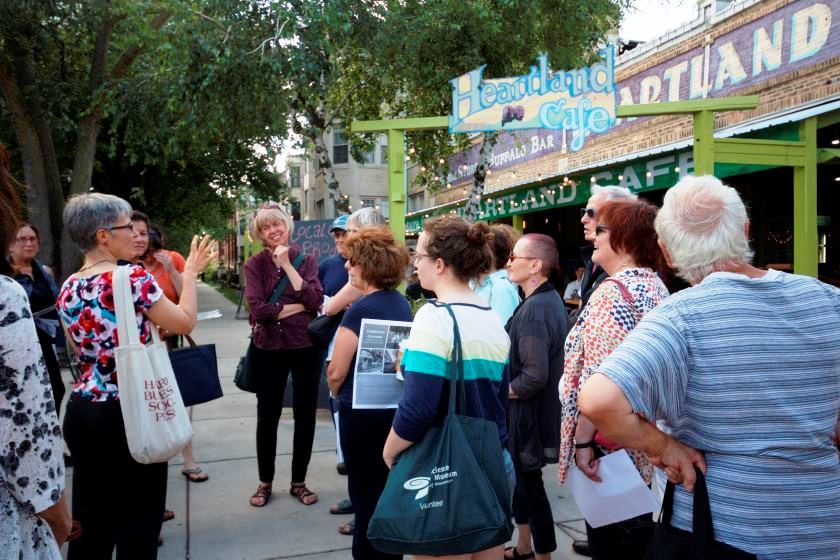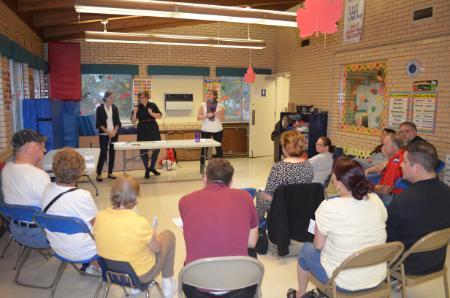archive
Students blend history with advocacy

Above photo: Loyola M.A. student Kristin Jacobsen leads a walking tour for the Rogers Park/West Ridge Historical Society as part of a class project organized by Public History Lab. (Photo: David Kogan)
By Anna Gaynor
The Public History Lab started with a handful of students. What it has turned into, however, is a full-scale campaign of projects, art walks, community days, faculty consults, and numerous proposals—all to support Chicago’s historic neighborhoods.
A student-led organization for those in Loyola’s public history program, the lab works with fellow students to help them make a difference outside the classroom.
“We’re learning all of these things, and it’d be great to actually apply some of the new skills we’re learning in the community,” said Hope Shannon, a PhD student in the joint public history and US history program. “It’d be great to take what we know out into the community and try and find somebody who we can help because we have all of these skills between us.”
The students have definitely found somebody to help. In the past few years, the lab has developed two main partnerships: one with the Rogers Park/West Ridge Historical Society, and the other with the Chrysler Village neighborhood on the city’s South Side.
“Sometimes there can be a disconnect between academic history and the public,” said Katie Macica, another PhD student. “I think the goal of public history is to engage the public with the past. So it’s really great to see how we can put that into practice, how we can use that to benefit the public.”
The partnership with the historical society began in 2013 when students approached the group’s board of directors to see if it could use their help.
“It immediately seemed perfect,” said Ken Walchak, the president of the board. “It was one of those things where you slap your head and say, ‘Duh, of course.’ It was great from day one.”
Since then students have helped develop a strategic plan, finessed mission statements, increased fundraising efforts, and more.
“It wasn’t our place at all to go in there and say you need to do x, y, and z,” Shannon said. “Our job, as we saw it and as we’ve been taught in the public history program, is to take our skills, go to a group, and say, ‘We know how to do these things. How would you like to apply that knowledge?’"
Staying local
Over the years, Shannon and Macica have become more involved with the historical society. Shannon, now head of the association’s media committee, and Macica, head of the education committee, were named to the society’s board in 2014 along with another Loyola student, Dan Ott, who has since graduated.
“Definitely something that drove the founders of the Public History Lab is starting these community collaborations,” Macica said. “Then the next part of that was, ‘Can we become the middleman between the community partnerships and the public history coursework? ’”
One of their biggest supporters has been Patricia Mooney-Melvin, PhD, the interim dean of The Graduate School, who teaches Public History: Method and Theory, one of the first classes students take in the program.
In the course, students work on two big projects relating to public history, so members of the Public History Lab approached her about incorporating their efforts into the classwork.
“It was from my standpoint a win-win situation because I could reorient the nature of the two projects that I have my students do,” Mooney-Melvin said.
This past fall, one of their class projects was to write a walking tour, similar to an art walk led by master’s student Kristin Jacobsen in August. The other was developing fundraising events drawing on the neighborhoods’ rich history.
The fresh perspective means everything for Walchak, whose family has owned Clark-Devon Hardware in Rogers Park since 1924.
“The typical member of the society has been and probably still is somebody like me—or somebody older than me, very honestly—often retired or semi-retired,” Walchak said. “To get young people in there with a whole different view of things has just been great. It’s energized everybody.”
Branching out
Rachel Boyle is another PhD student involved with the historical society, and she’s also spearheading the Chrysler Village History Project. She and other public history students are working with the Clearing neighborhood and the local alderman to bring attention to the small subdivision. The project started after students successfully nominated Chrysler Village to the National Register of Historical Places in the Management of Historical Resources course taught by Professor Theodore Karamanski, PhD.

Above photo: Members of the Chrysler Village project talk with residents of Clearing and Chrysler Village. (Photo: Chrysler Village Project)
The following fall, Boyle and a handful of her classmates decided to continue the project, enlisting Mooney-Melvin’s class for ideas on how to develop a vibrant community program and also gathering the stories of its residents in their course, Oral History: Method and Practice.
Beyond preserving history though, Boyle sees how their efforts can bring economic and social benefits to the community. With higher visibility, the neighborhood may find more funding for infrastructure projects and potential tax breaks.
“We know about the Chicago fire, we know about the world’s Columbian Exhibition in 1893,” Boyle said. “Where does Chrysler Village fit in that? What would happen if Chrysler Village was a part of that story that we tell? Well then, we wouldn’t be so quick to overlook it in city politics and in the city’s history.”
Mooney-Melvin also has some experience with helping local communities. In 1993, she worked with Rogers Park and West Ridge to commemorate the neighborhoods’ 100th anniversary of their annexation to Chicago.
“I strongly believe that as a University, we have a commitment to the places where we reside,” Mooney-Melvin said. “To me, it seems really important to not just be users or consumers but to also give something back. The students saw this as an opportunity for them to enhance some of their skills—but also as a real way to make a contribution.”
